Nosler 65 Creedmoor 120 Grain Ballistic Tip Ammo Review
While they each have different strengths and weaknesses, .308 and .270 Winchester cartridges are both proven performers. So, the question cardinal to the 270 vs 308 debate remains: which one should y'all be hunting with?
I remember the majority of hunters and shooters would agree that the .270 Winchester and .308 Winchester are outstanding hunting cartridges. Indeed, they're both consistently amid the most pop centerfire burglarize cartridges used in the United states of america each year for practiced reason.
While each cartridge offers sure benefits to hunters, there is too a pretty big overlap in their capabilities. For those reasons, agreement their true strengths and weaknesses can be pretty confusing at times. The fact that the .270 and .308 each accept very devoted fan clubs tin can also make information technology hard to navigate the argue.
Don't become discouraged though: in today's blog mail, I'yard going to discuss the pros and cons of the 270 vs 308 then you can make an informed decision on which one is best for you.
Before we get started, I have a couple of administrative notes:
Some of the links below are affiliate links. This ways I will earn a small commission (at no extra cost to you) if you brand a purchase. This helps support the weblog and allows me to continue to create complimentary content that'southward useful to hunters like yourself. Thank you for your support.
Finally, I recorded an entire podcast episode on this exact subject. If you'd rather listen than read, click the appropriate link below to listen to this episode on your preferred podcasting service.
308 vs 270 Podcast
Apple | Google | iHeart | Spotify | Stitcher
270 vs 308: History
Similar many other cartridges developed in the United States, the story of the .270 and .308 Winchester begins with the .30-06 Springfield.
The U.s.a. Army began the search for a new rifle and cartridge after receiving a deadly demonstration of the capabilities of the revolutionary new Mauser rifle and 7mm Mauser cartridge in the hands of Castilian troops in Cuba during 1898. Those efforts bore fruit a few years later with the commodities activity 1903 Springfield rifle chambered in the new .xxx-06 Springfield cartridge.
Using smokeless powder and a 150gr pointed bullet fired at 2,700fps, the .30-06 Springfield was a gigantic improvement over other popular American cartridges used during that era like the .30-30 Winchester and the .45-70 Government.
Not surprisingly, the .30-06 Springfield was an almost instant success in the civilian market.
While many were satisfied with the .30-06 from the start, wildcatters likewise quickly started modifying the cartridge for more specialized tasks. Some gun designers necked upward the .xxx-06 to develop bigger cartridges like the .35 Whelen and .400 Whelen.
However, the folks at Winchester went the contrary route and necked downwards the .xxx-06 (specifically the erstwhile .xxx-03 instance, which the .30-06 is descended from) to apply .277″ instead of .308″ bullets. They formally released the resulting .270 Winchester cartridge in 1925 with the Winchester Model 54 burglarize.
The original .270 Winchester load shot a 130 grain bullet at a velocity of 3,140 feet per 2nd (ii,846 ft-lbs of energy).
If y'all'd like to run into how the .270 Winchester compares to its parent case in the .thirty-06, read the article beneath:
270 vs 30-06 Argue Settled In one case And For All
While the .270 had a very high muzzle velocity compared to other popular cartridges of the day, it was not an instant commercial success. This was due to a number of reasons, one of which was the fact that the .270 Winchester fired unusual size bullets. Instead of .284″ bullets similar the 7mm Mauser (and more recently developed cartridges like the 7mm-08, .280 Remington, .280 Ackley Improved, and 7mm Remington Magnum), the .270 Winchester used .277″ bullets which undoubtedly hampered adoption of the cartridge to a certain caste.
It's unclear exactly why Winchester opted for .277″ instead of the much more pop .284″ bullets. Regardless of their reasons though, the design squad at Winchester went with that bullet bore and the balance is history. Interestingly enough, while the .270 Winchester eventually became a gigantic commercial success for the company, bated from the .270 Winchester Short Magnum (270 WSM), the .270 Weatherby Magnum, and the 6.8 Remington SPC, virtually no other mass produced cartridges use .277″ bullets.
Helped along by Jack O'Connor and the famous articles he wrote for Outdoor Lifeabout the .270 over the years, the cartridge gradually caught on with the hunting customs. Though some were reluctant to adopt the cartridge, many American hunters somewhen came to appreciate the apartment shooting characteristics of the circular every bit well as the fact that it was then constructive on thin skinned game. Within a few decades, the .270 Winchester was firmly entrenched as one of the most pop hunting cartridges used in the Usa.
While the .30-06 performed very well during both globe wars, the U.s. Military machine again recognized the demand for a new rifle and cartridge after Earth War Two. Specifically, the military wanted a new rifle chambered in an intermediate cartridge, capable of automatic fire, and equipped with a detachable mag.
If you'd like to learn more than about the evolution of intermediate cartridges, read the article below.
223/5.56 vs vii.62×39: Everything You Need To Know
After a very controversial option process, the Army eventually settled on the Thou-14 rifle and the new 7.62x51mm NATO cartridge.
The original vii.62x51mm NATO M80 ball load fired a 146 grain total metal jacket (FMJ) bullet at ii,750 feet per second (ii,469 foot pounds of cage energy). The seven.62x51mm NATO had near the same ballistics equally the original .30-06 Springfield load (150 grain bullet at 2,700 feet per second) and also fired a .308″ bullet. However, the 7.62x51mm achieved that performance with a much shorter case (51mm vs 63mm) due to advances in powder engineering that occurred after the development of the .30-06.
Though the 7.62x51mm NATO had a very short lived career as the chief rifle cartridge for the US military, it'due south still widely used past the armed forces in machineguns and sniper/designated marksman rifles. Additionally, Winchester recognized serious commercial potential with the 7.62x51mm cartridge and introduced the extremely similar .308 Winchester cartridge for the noncombatant hunting and shooting markets in the 1950s.
Providing approximately xc% of the power of the .30-06 in a smaller parcel, the cartridge presently became very pop and is at present one of the nearly widely used big game hunting rounds in North America.
If you'd like to larn more about how the .308 Winchester compares to the .xxx-06 Springfield, read the article below:
308 vs thirty-06 vs 300 Win Mag: Which 1 Should You Be Hunting With?
270 vs 308: Cartridge Sizes
As yous can see in the photo below, the .270 Winchester and .308 Winchester cartridges accept very different external dimensions.
The .270 Winchester has a significantly longer case length (2.54″ vs 2.015″) too as overall length (3.34″ vs 2.81″). For this reason, the .270 Winchester is used in standard/long activeness rifles, while the .308 Winchester is the poster kid for short activity rifles.
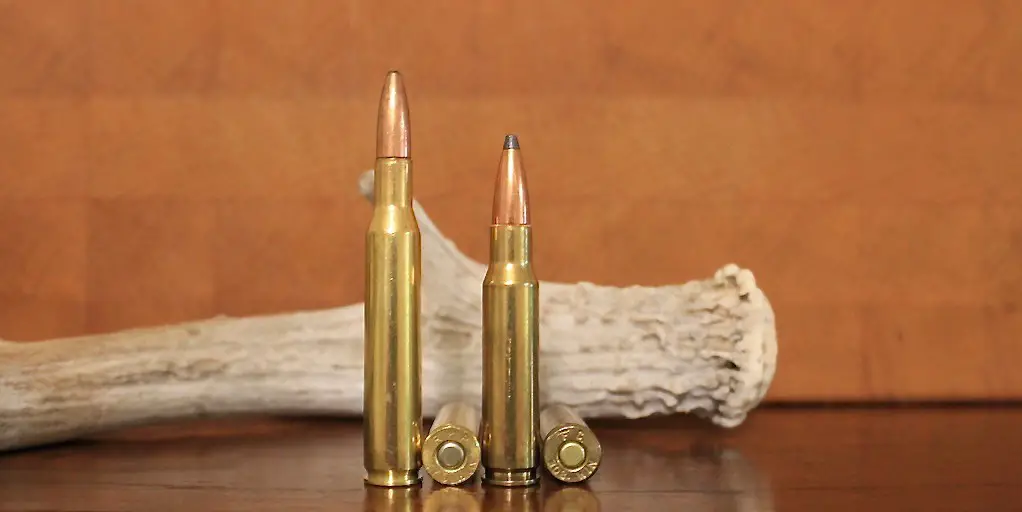
Both cartridges have the aforementioned .473″ rim diameter. All the same, the .308 has a slightly steeper shoulder bending (20 degrees vs 17.5 degrees). Yet, the .270 Winchester has significantly more case chapters due to the much longer case used past the cartridge.
Finally, the .270 Winchester has a slightly higher maximum boilerplate pressure authorized by SAAMI (65,000psi vs 62,000psi for the .308 Win).
Annotation: while the case capacity figures listed beneath practice give a good indication of the differences between the three cartridges, exact case capacities vary slightly according to the brand of brass used.
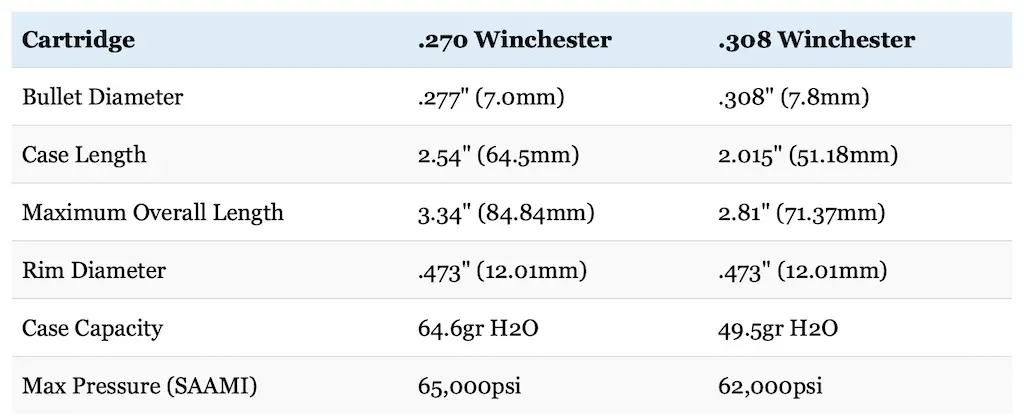
270 vs 308 Ballistics
Past necking down the .30-06 instance to shoot smaller bore bullets, the designers of the .270 Winchester built a cartridge with a college velocity, flatter trajectory, and less recoil than the .30-06 Springfield. Since the .308 Winchester is essentially a scaled down .30-06, with the exception of recoil (which we'll go to in a minute) the .270 Winchester has the aforementioned advantages over the .308 as information technology does over the .30-06.
However, since most modernistic .xxx-06 factory loads have a pocket-sized edge in velocity (normally around 100-200fps) over .308 factory loads shooting the same weight bullet, the advantage in velocity of the .270 Winchester is even more pronounced when compared to the .308.
This is because the smaller diameter .270 Winchester shoots lighter bullets than the .308 and the .30-06.
For example, though information technology'south possible to find .308 ammo shooting bullets weighing every bit petty as 110 grains, most .308 Winchester factory loads designed for big game hunting utilize heavier weight bullets in the 150 grain to 180 grain range. 150 grain, 165 grain, 168 grain, and 180 grain bullets are virtually popular for that cartridge. On the other hand, the bulk of .270 Winchester factory loads shoot bullets in the 120-150 grain range. Of these, 130 grain and 150 grain bullets are past far the well-nigh mutual.
Additionally, everything else existence equal, the smaller diameter bullets used past the .270 Winchester have a college ballistic coefficient than the larger diameter bullets of the same weight from the .308 Winchester.
However, the .308 Winchester tin utilize heavier bullets than .270 Winchester.
This is illustrated beneath when comparing four different Federal Premium Nosler Partition loads for the 2 cartridges. Specifically, the table below compares 130gr (.416 BC) and 150gr (.466 BC) loads in .270 Winchester and 150gr (.387 BC) and 180gr (.484 BC) loads in .308 Winchester.
As yous can see, the 180gr .308 load uses a slightly more aerodynamic bullet than those used by the .270. Withal, the 130gr and 150gr Nosler Division bullets used in this comparison past the .270 are both more aerodynamic than the 150gr .308 bullet.
This data is for Federal factory ammo using a 200 thou null.
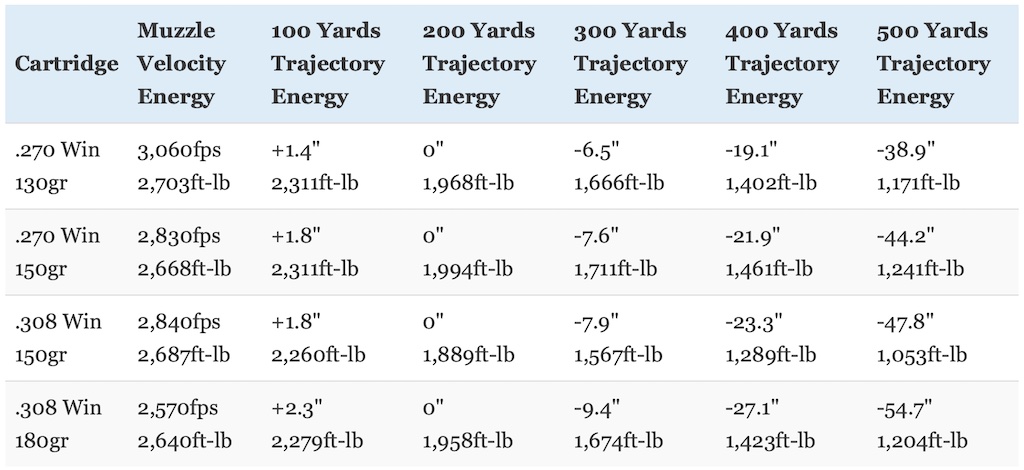
Not surprisingly, there is a pregnant difference in the bullet trajectories between the two cartridges.
The .270 Winchester has a slight edge over the .308 when both are using 150gr bullets. However, the 130gr .270 load has an even flatter trajectory with viii.nine-15.8″ less bullet driblet at 500 yards than both .308 Winchester loads.
With regards to energy, the cartridges are adequately evenly matched to showtime out with. The gap in kinetic free energy grows slightly in favor of the .270 when compared to the 150gr .308 Winchester load at all ranges. Even so, the reverse happens with the more aerodynamic 180gr .308 Winchester load at longer range.
All things considered, the 2 cartridges are fairly evenly matched in energy.
The chart below compares how much a x mile per 60 minutes crosswind impacts those aforementioned 4 loads out to 500 yards.
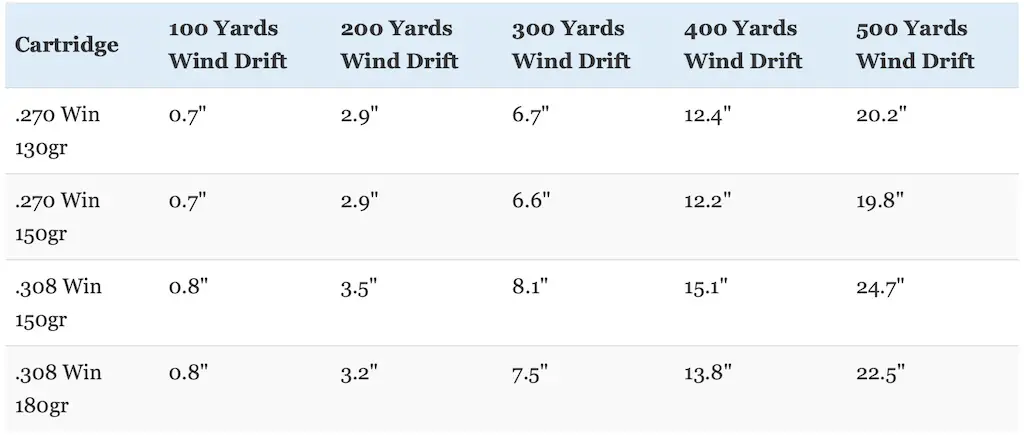
Again we see that the two cartridges are adequately evenly matched at shorter range, merely the .270 has a slight advantage in wind drift that grows as range increases. This is because the .270 Winchester loads shoot more aerodynamic bullets (with the exception of the 180gr .308 load) at a higher velocity.
Now let'due south talk most recoil.
The table below compares the recoil produced past 130gr and 150gr .270 loads to 150gr and 180gr .308 loads (all shooting a Nosler Partition bullet) when fired from identical vii pound rifles.
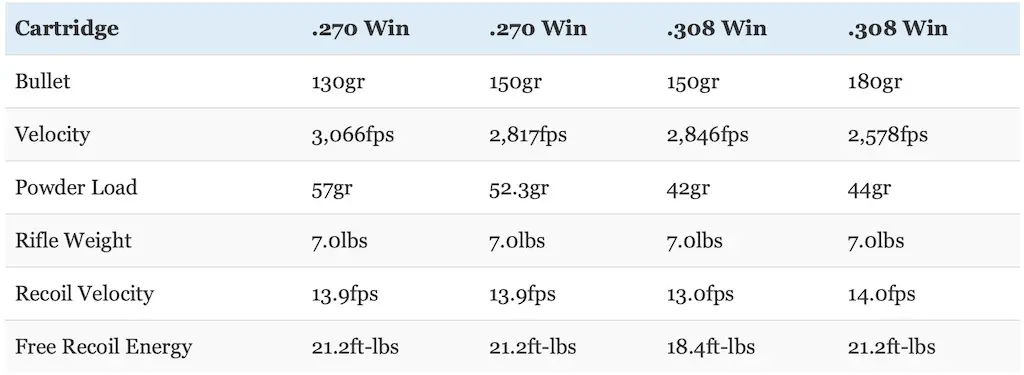
Felt recoil will vary from shooter to shooter and rifle to rifle, but complimentary recoil energy is notwithstanding a useful way to compare cartridges.
Interestingly, with the exception of the milder recoiling 150gr .308 load, the two cartridges take almost identical recoil.
However, that makes sense when you consider that the .308 and .270 were designed as lower recoiling alternatives to the .xxx-06. This fits with the original intent of the designers interested in building a mild shooting and easy to handle cartridge that was still powerful plenty for hunting medium sized game at short to moderate range.
Then where do we stand with each cartridge?
The .270 Winchester is a very flat shooting and moderately powerful cartridge, peculiarly considering that it'south nearly 100 years onetime. With moderate recoil that's roughly comparable to the .308 and noticeably lighter than the .30-06 Springfield, virtually shooters and hunters can handle it without much trouble.
While recoil is more than or less comparable between the two cartridges, typical .308 Winchester loads practise non take equally flat of a trajectory every bit typical .270 loads.
However, the .308 is available with heavier bullets than the .270 and is bachelor in a wider range of bullet weights and models.
Equally we'll talk over in a minute, this is partly due to the widespread use of the .308 Winchester (and other .xxx quotient cartridges like the .thirty-06, .300 Win Magazine, .300 Ultra Mag, and 300 China) in long distance shooting competitions. These projectiles quite often accept advantage of the latest developments in bullet development and offer advantages in precision and ballistic coefficient compared to the bullets used by the .270.
Additionally, there are a couple of other factors that are besides worth discussing though.
First, the .308 Winchester uses larger bore bullets than the .270 Winchester.
Specifically, the larger bore .308″ bullets used past the .308 have about 24% more frontal surface surface area (also known equally cross sectional area) than the .277″ bullets used past the .270 (.0745 vs .0603 square inches). All other things being equal, a bigger bullet will make a bigger hole, crusade more tissue damage, and result in more blood loss.
This is a definite, though slight, factor in favor of the .308.
On the other paw, many of the .277″ bullets have a higher sectional density (SD) than the near common bullets used in the .308 though.
Sectional density (SD) is a measure of the ratio of the diameter of a projectile to its mass. All other things equal, a heavier projectile of a given caliber volition exist longer and therefore accept a college sectional density and consequently penetrate deeper than projectiles with a lower mass and exclusive density.
Everything else being equal, the smaller bore .277″ bullets have a college ballistic coefficient and a higher sectional density than the larger bore bullets of the same weight from the .308. However, the .308 generally uses heavier bullets than the .270 Winchester.
All that being said, the .270 Winchester still has a slight edge with most bullets in common apply, even when compared to heavier .30 caliber bullets.
As an example, 130 grain, 140 grain, and 150 grain .277″ bullets have sectional densities of .242, .261, and .279 respectively. This compares favorably to 150 grain, 168 grain, and 180 grain .308″ bullets which have sectional densities of .226, .253, and .271 respectively.
For the most part, this also applies to ballistic coefficient.
The bullets used in this comparison illustrate those differences well with the .270 Winchester using 130gr (.416 BC) and 150gr (.466 BC) bullets compared to the 150gr (.387 BC) and 180gr (.484 BC) bullets used past the .308.
With the exception of the 180gr .308 bullets, the .270 has the edge beyond the lath with regards to using more aerodynamic bullets in this comparison.
It'southward difficult to pick an accuracy winner between the 270 vs 308 though because it's something of an apples to oranges comparison. Both cartridges are capable of outstanding accurateness, simply the .270 Winchester is used virtually exclusively as a hunting cartridge. On the other manus, fifty-fifty though the .270 Winchester does shoot flatter in many cases, war machine and constabulary snipers, hunters, and practical and/or long distance shooting competitors have all used the .308 Winchester extensively over the years.
For that reason, users of the .308 Winchester benefit from the extensive the research and development that has gone into refining .308″ bullets and rifles for long range shooting in the U.s.a. over the concluding century.
All that being said, while the .308 probably has a slight edge here, both cartridges have the potential for excellent accuracy in the correct hands.
If you lot'd like to learn more about the accuracy of the .308 Winchester and how it compares to cartridge purpose built for long range competition shooting, read this commodity:
half-dozen.v Creedmoor vs 308 Winchester Debate Settled

308 vs 270: Ammunition Option
The .308 Winchester and .270 Winchester are two of the virtually pop centerfire rifle cartridges in N America. In fact, I'd wager that they're both amongst the Top 10 (if non the Top five) all-time selling rifle cartridges in the United States each year.
Non surprisingly, pretty much every armament manufacturer of annotation like Barnes, Black Hills, Browning, Federal Premium, Fiocchi, Hornady, Magtech, Nosler, PMC, PPU, Remington, Swift, and Winchester (just to name a few) produce a wide diverseness of ammo for both cartridges.
Virtually every major manner of bullet is available in .270 and .308 besides like the Barnes TTSX, the Hornady ELD-X, GMX, InterBond, InterLock, SST, and V-Max, the Nosler AccuBond, AccuBond Long Range, Ballistic Tip, Due east-Tip, and Segmentation, the Remington Core Lokt, the Swift Scirocco and A-Frame, and the Winchester Power Bespeak (just to name a few).
Prices and availability vary from region to region, merely armament for both cartridges is widely available. In fact, if a sporting goods shop but carried ammo for three different centerfire rifle cartridges, I'd bet money they'd have .270, .308, and .30-06 ammo.
Basically, there is no shortage of quality .270 Win and .308 Win factory armament suitable for hunting.
BUY SOME GREAT 270 HUNTING AMMO HERE
Buy SOME GREAT 308 HUNTING AMMO HERE
If y'all'd like to larn more about some of the various hunting ammunition choices for the .308 Winchester and .270 Winchester cartridges, read the articles below:
Best 270 Ammo For Hunting Elk, Deer, And Other Big Game
Best 308 Ammo For Hunting Deer, Elk, Hogs, & Other Game
Both cartridges are too well suited for handloaders and reloading components for both cartridges are widely available. With regards to bullet choice, .308″ bullets in particular are very easy to discover. Though only a few cartridges use .277″ bullets, the .270 is extremely popular and there's a plethora of quality bullets to choose from.
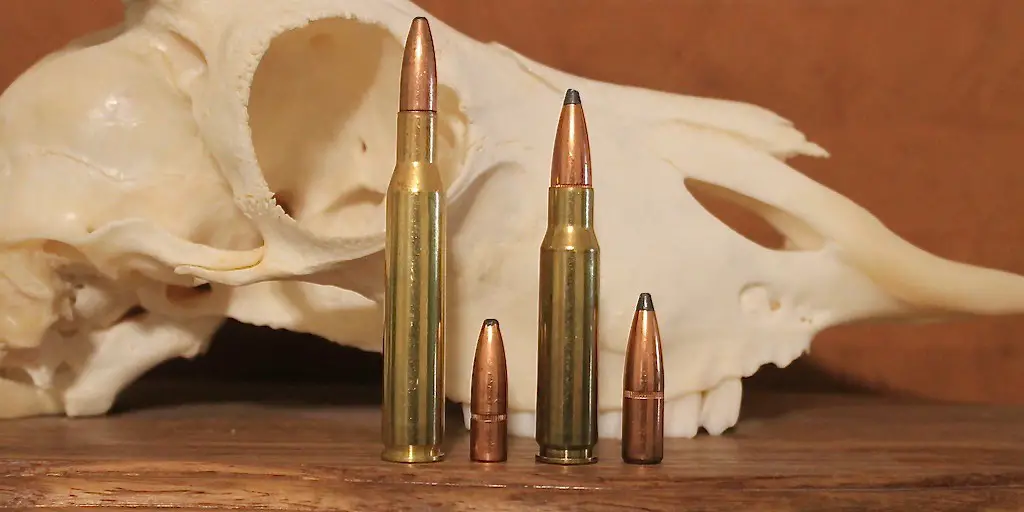
308 vs 270: Rifle Selection
Like to the arable ammunition choices bachelor in .308 Winchester and .270 Winchester, there are also enough of quality rifles manufactured in the two cartridges. Regardless of the cartridge y'all choose, finding a practiced deer rifle shouldn't be an event.
Both are very common in bolt-action rifles. Of class Remington and Winchester produce the Model 70 and Model 700 rifles in .270 and .308 Winchester. Additionally, the Browning 10-Bolt, Kimber Hunter, Mossberg Patriot, Nosler Liberty, Ruger American, Ruger Eagle, Brutal Axis, Thompson Heart Compass, Tikka T3, and Weatherby Vanguard are available in both calibers.
BUY A Bang-up 270 HUNTING Rifle Hither
BUY AN EXCELLENT 308 HUNTING Rifle Hither
Aside from the Browning BAR, the .270 Winchester is almost non-existent in semi-automatic rifles. On the other hand, the .308 Winchester is relatively mutual in semi-automated sporting rifles like the AR-ten and M1A.
Though there is quite a bit of overlap in barrel lengths, .270 rifles often have slightly longer barrels than .308 rifles. That's not a difficult and fast rule though, and 22″ and 24″ barrels are very common for both cartridges.
All things considered, identical rifles chambered in .270 Winchester tend to be slightly longer, heavier, and more unwieldy than rifles chambered in .308.
The Winchester Model 70 Super Grade illustrates these differences well.
When chambered in .308 Winchester, the burglarize has a 22″ butt, an overall length of 42.25″, and weighs 7.75 pounds. The aforementioned rifle chambered in .270 Winchester has a 24″ butt, is 44.75″ long, and weighs 8.25 pounds.
So, the rifle chambered in .270 Winchester is 2″ longer and weighs about a half pound more than than the exact same model chambered in .308 Winchester.
Butt lengths exercise vary depending on the manufacturer and verbal model.
At the same time though, the .308 Winchester is sometimes available in more compact rifles with shorter eighteen-20″ barrels.
Having a shorter and lighter rifle is more important on some hunts than on others. So, just go on that in listen.
270 vs 308: Which Is Right For You?
With good shot placement and when using quality bullets, the .270 Winchester and .308 Winchester are ideally suited for hunting medium to big sized game.
They are both incredibly effective (and popular) deer hunting cartridges and hunters armed with the .270 and .308 brand up a significant portion of the annual whitetail deer harvest each year in the United states of america. Both are likewise neat for similarly sized game like black carry, feral hogs, javelina, mule deer, and pronghorn too as exotic game like axis, sika, and fallow deer.
Yet, the flat trajectory and resistance to wind drift of the .270 Winchester makes information technology a really good option for game that might crave a longer shot such as pronghorn or mule deer. The relatively light recoil of the cartridge also makes information technology easier to handle in a lightweight burglarize that's desirable on a mountain hunt. Jack O'Connor was really onto something with his affinity for the .270 as a sheep hunting cartridge. Those aforementioned characteristics too arrive a very good choice for mount goat in Canada or Himalayan Tahr and chamois while hunting in New Zealand.
On the other hand, since it shoots heavier and larger diameter bullets, the .308 Winchester has a clear advantage when hunting larger species like moose, elk, and caribou. Peculiarly when using a heavy bullet (180+ grains), the .308 has a meaning advantage when hunting most plains game in Africa like blue wildebeest, kudu, and eland.
Now the .308 Winchester is a perfectly capable long range cartridge and plenty of hunters employ it on mountain hunts each year. Later on all, the recoil of the .308 is very similar to the .270. By the aforementioned token, the .270 has taken untold numbers of moose, elk and plains game without any problems. For example, the 150gr Nosler Division beneath actually did a number on a large kudu bull in South Africa.
It's really just a matter of each cartridge having certain strengths and weaknesses.
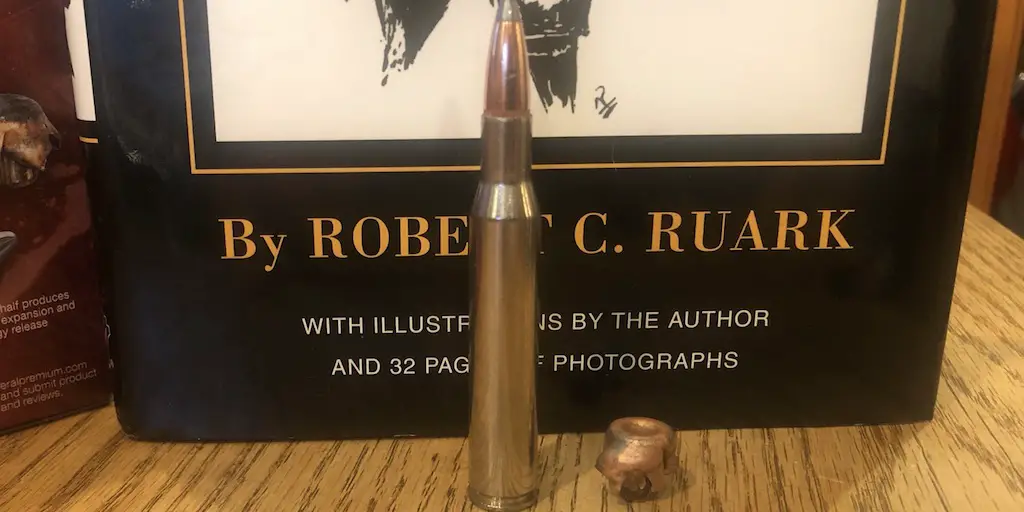
Exercise you primarily hunt medium sized game similar whitetail deer, feral hogs, or black bear at ranges within 200 yards? Both are extremely effective deer hunting cartridges and will absolutely get the job done on medium sized game if you do your part. Both are swell deer hunting cartridges and are amongst the most popular North American hunting cartridges in general, so information technology'due south really difficult to go incorrect here.
If you lot're going to be hunting in thick brush or in the tight confines of a deer stand up, recollect what I just mentioned about the size departure with 308 vs 270 rifles. That extra couple of inches in overall length of a burglarize tin can exist a real headache to bargain with when trying to quickly and quietly maneuver for a shot.
Are you looking for the cartridge better suited for long range hunting for game like mule deer or pronghorn in open up country where you might need to accept a shot at several hundred yards? Both will work, but the .270 Winchester is probably the better choice for you. With a significantly flatter trajectory and more resistance to air current, the cartridge does very well on longer shots, particularly on thin skinned game similar mule deer, pronghorn, sheep, or tahr.
Practise you want to hunt larger game animals like kudu, eland, red stag, elk, or moose? Neither would be my offset choice for this sort of hunting, but both cartridges will certainly work and lots of people have used them with success on bigger game. In my opinion, the .308 Winchester is probably the improve choice in this example since it uses larger diameter and heavier bullets that are well suited for very big or tough animals.
Regardless of which cartridge yous choose, apply a controlled expansion projectile and a heavier bullet weight for your elk or moose hunt.
Even though they have slightly different strengths and weaknesses, the .270 Winchester and .308 Winchester are outstanding rifle cartridges. While the differences between them (.270 vs 308) are pretty significant in some respects, they're both acceptable for a wide range of hunting tasks.
Get a nice hunting burglarize chambered in the cartridge that you think fits your needs the best, learn to shoot information technology well, apply quality bullets, and you'll be well prepared for most mutual hunting situations.
Are you just itching to take a rifle chambered in i of these cartridges on a hunt?
Volume an excellent black bear hunt here.
Book an outstanding Africa hunting safari hither.
Enjoy this article comparing the .270 and .308 Winchester cartridges? Delight share it with your friends on Facebook and Twitter.
The Lyman 50th Edition (197-198, p241-245), and Hornady 10th Edition (p251-355, p474-488) reloading manuals were too used every bit references for the history of the cartridges and provided data to compare their size and recoil. Ballistic data for the original 7.62x51mm military cartridge was obtained from Inetres. The data used to compare the trajectory and air current drift of the cartridges was obtained from Federal. Maximum force per unit area obtained from SAAMI (p171 and p172). Example capacities for the .270 Win and .308 Win were obtained from Nosler. I used the Federal Ballistic calculator and ShootersCalculator.com to compare current of air drift, the range each bullet goes subsonic, and recoil for the cartridges.
Make sure yous follow The Big Game Hunting Blog on Facebook, Instagram, Twitter, and YouTube.
NEXT: 7mm REM MAG vs 300 WIN MAG: WHAT YOU KNOW MAY BE WRONG
NEXT: 101 Best GIFTS FOR HUNTERS
Side by side: 11 All-time HUNTING EAR PROTECTION OPTIONS FOR SPORTSMEN
Source: https://thebiggamehuntingblog.com/270-vs-308/
Post a Comment for "Nosler 65 Creedmoor 120 Grain Ballistic Tip Ammo Review"